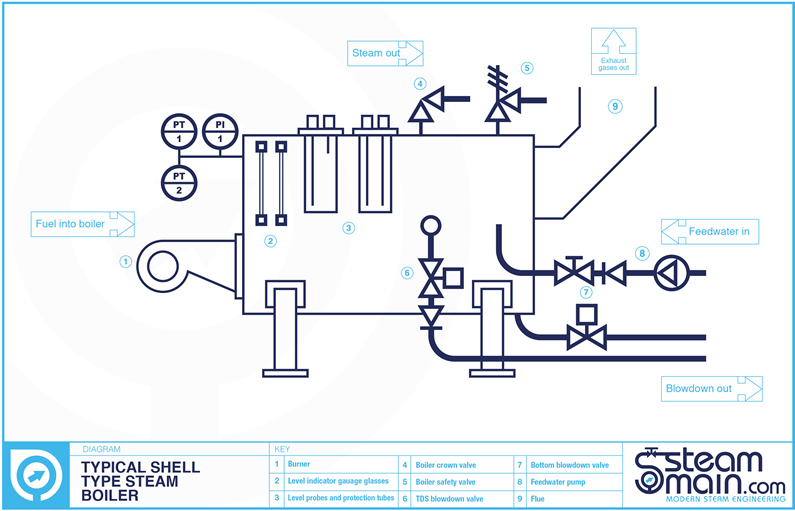To protect a steam boiler, and produce the correct quality of steam, the water quality in the boiler must be maintained. Even when a good and correct water treatment plant and regime is used there will still be a requirement to blow impurities out of the boiler. If we use a shell type boiler as an example, this is done in two ways; using TDS blowdown, and bottom blowdown.
Minimizing the blowdown rate can reduce energy losses, as the temperature of the blown down liquid is the same as that of the steam generated in the boiler. Minimizing blowdown will also reduce makeup water and chemical treatment costs.
The total dissolved solids level in the boiler must be kept to a set level or set point. This is normally done using a side connection on the boiler, a TDS conductivity probe, and a control valve. The probe measures the TDS level in the water in the boiler and opens and closes the valve as desired to remove the TDS laden water from the boiler.
The second blowdown from the boiler is normally located at the bottom and back of the boiler. It is used to remove the sludge or sediment that accumulates at the bottom of the boiler shell. Therefore it is only opened for a short period of time (a few seconds), and normally only a few times a day at most. The valve can be opened manually using a key to operate the valve (a key is used so only one boiler can be blowdown at any one time, on multi boiler installations). Alternatively it can be automated using an air operated valve on a timer.
As bottom blowdown happens for a very short set time and is very intermittent there is little scope for trying to save energy. However with TDS blowdown the story can be different as it is often a continuous process.
Insufficient blowdown may lead to carryover of boiler water into the steam, or the formation of deposits. Excessive blowdown will waste energy, water, and chemicals. The optimum blowdown rate is determined by various factors including the boiler type, operating pressure, water treatment, and quality of makeup water. Blowdown rates typically range from 4% to 8% of boiler feedwater flow rate, but can be as high as 10% when makeup water has a high solids content.
The boilermaker and water treatment company should therefore be consulted to ensure that set point levels are correct.
Example of changing TDS blowdown set points:
A 10,000 kg/hr rated steam shell boiler operating at 10barg, and actually developing 5,000 kg/hr of steam. The feedwater TDS having a level of 200ppm. Feedwater temperature at 90 °C.
TDS set point at 2000 ppm:
(ppm feedwater TDS/ppm boiler TDS – ppm feedwater TDS) x (100/1) = % blowdown
(200/2000-200) x (100/1) = 11.1 %
Steaming output required x (100 + % blowdown)/100 = amount of water to be supplied to boiler
5000 x (100+11.1)/100 = 5,555 kg/hr
(total flow rate required x (sensible heat hf at 10 barg – sensible heat hf at 90 °C))/3600 = energy required to raise to saturating temperature
5555 x (782–376)/3600 = 626 kw
(steam flow rate x latent heat of steam hfg)/3600 = energy required for steam
5000 x 2000/3600 = 2,778 kw
Therefore total energy used to generate 5,000 kg/hr of steam = 3,404 kw
TDS set point at 3500 ppm:
(ppm feedwater TDS/ppm boiler TDS – ppm feedwater TDS) x (100/1) = % blowdown
(200/3500-200) x (100/1) = 6.1 %
Steaming output required x (100 + % blowdown)/100 = amount of water to be supplied to boiler
5000 x (100+6.1)/100 = 5,305 kg/hr
(total flow rate required x (sensible heat hf at 10 barg – sensible heat hf at 90 °C))/3600 = energy required to raise to saturating temperature
5305 x (782–376)/3600 = 598 kw
(steam flow rate x latent heat of steam hfg)/3600 = energy required for steam
5000 x 2000/3600 = 2778 kw
Therefore total energy used to generate 5,000 kg/hr of steam = 3,376 kw
Energy savings:
Reduction in energy, 3404 – 3376 = 28 kw
Reduction in energy cost, (28/3404) x (100/1) = 0.82 % saving in fuel
Next steps:
- Check blowdown set points and procedures to identify potential energy saving opportunities.
- Consider an automatic blowdown control system if this had not already been fitted.
- In our future articles we will look at saving energy by increasing feedwater quality, and recovering the energy from TDS blowdown.

